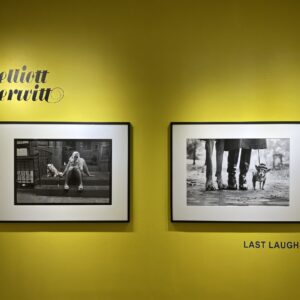JTF (just the facts): A total of 24 color photographs, framed in white and matted, and hung against white walls (including a divider) in the back gallery space. All of the works are cibachrome prints, made in 1985. Physical sizes are either 8×10, 11×14, or 16×20 (or reverse) and no edition information was provided. (Installation shots below.)
Comments/Context: When we talk about the “late work” of an artist/photographer, we are by definition drawing a chronological contrast with the images produced years earlier, looking for reasons why an artist’s style, subject matter, or point of view might have changed over time. In the case where a visual artist is elderly, in failing health (particularly sight), or terminally ill, this output can often take the form of a final statement or perhaps a deliberate summing up, where ideas of mortality can infuse the process and aesthetic approaches can wander from pared down essentials to last gasp exuberance. Whatever the situation, this late work is nearly always inextricable from its context, so it is here that we often start when in search of explanations.
In 1985, Jimmy DeSana was suffering from AIDS and had just had his spleen removed (he would ultimately die from the disease in 1990), and the pictures gathered in this exhibit were selected by the artist as a representative sample of his work at the time. In contrast to the body-centric subversiveness that had made his previous photographs so open and playful, these images take a conscious turn away from that conceptual risk-taking and flamboyance, bringing a darker emotional struggle into the mix in a variety of symbolic ways. While his signature bright, saturated, gel-filtered colors remain, the overall mood in these pictures is decidedly more introspective and end-of-days.
While nudes (both male and female) made up a significant proportion of DeSana’s previous imagery, the bodies and faces in these late pictures are often covered, obscured, or intentionally distorted. Puffed up bodies balloon to fill oversized clothes, cowboy hats, trucker caps, and crinkled aluminum foil (all signifiers) cover the artist’s head, and faces are peeled back like exploding starbursts. Several of the staged scenes (in some cases, self-portraits) lean toward overt religious allegory, with cellophane tape being pulled out of a mouth like an endless stream of speech or a makeshift Madonna and child with pizza crust halos flying through the air. And a few images push bodies into more elemental zones, like a statuesque male form with a billowing drape of fabric, or a fetal silhouette in high heels in electric, amniotic magenta, covered in a swirl of chocolate syrup. Seen together, there is a sense of DeSana unpacking himself, trying to make sense of the component parts of his persona.
The show also includes many more still lifes than before, allowing for more process-based experimentation and an emptying out of tight emotion. Rephotographed arrays of saltine crackers and ravioli sit atop a plastic doll and an inflatable Halloween skeleton, juxtaposing symbols and meanings with subtle eeriness. Photogram twist ties intermingle with roses like bright barbed wire. A dalmatian sits in a chair, its spots reversed in negative tonalities and bathed in blue; the same dog reappears in another picture underneath an expressive tangle of mustard and ketchup. An aluminum foil sheath creates a keyhole view to a dark and foreboding seascape. And singular objects are freighted with heavier implications – the balancing of a sharp blade, a lonely selection of empty spools, and a worn softball teetering on a steep incline. In each formal study, a dark emotional undercurrent isn’t far from view.
There is visceral strength in DeSana’s late work that gives it durable vitality. These images offer us a window into an artist wrestling with his own demise, and doing so with an authentic urgency that adds poignancy to each and every effort. Filled with uncertainty and foreboding, the photographs push and pull, fully aware that easy equilibrium is no longer possible.
Collector’s POV: The prints in this show are priced between $8000 and $15000. DeSana’s work has very little secondary market history, with only a handful of lots coming to market in the past decade or so. As such, gallery retail likely remains the best option for those collectors interested in following up.
















